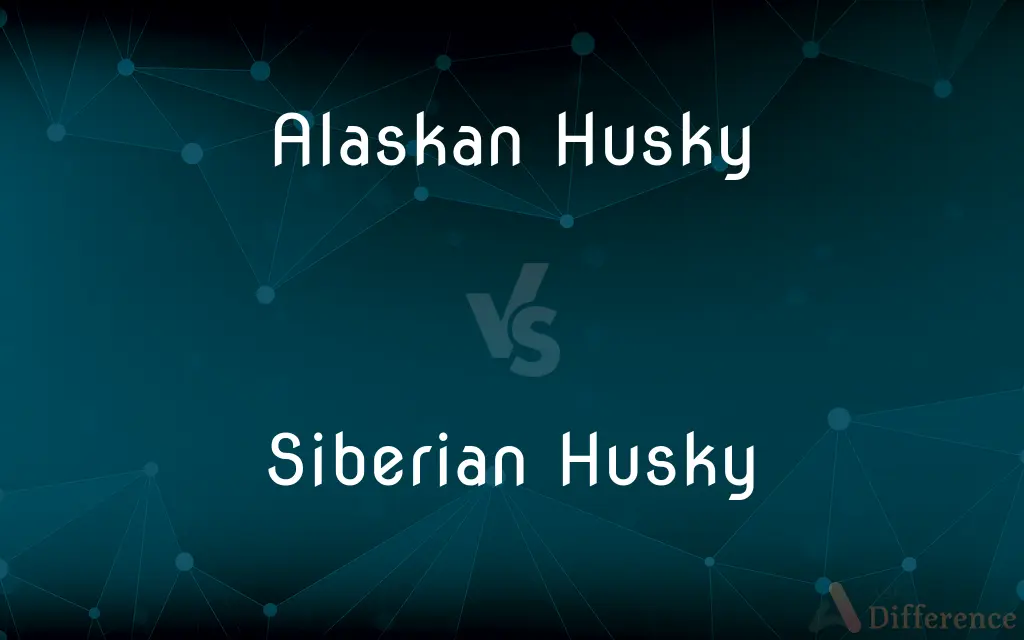Alaskan Husky vs. Siberian Husky — What's the Difference?
By Tayyaba Rehman — Published on December 18, 2023
Alaskan Husky is a mixed-breed, working dog; Siberian Husky is a purebred, known for blue eyes.

Difference Between Alaskan Husky and Siberian Husky
Table of Contents
ADVERTISEMENT
Key Differences
The Alaskan Husky and the Siberian Husky occupy unique spaces within the realm of sled dog breeds. The Alaskan Husky is notably recognized as a performance dog with a prime focus on its working ability, while the Siberian Husky is acknowledged as a pure breed with a documented lineage.
Diving into physical attributes, Alaskan Huskies are often mixed and might not adhere to a consistent physical appearance, while Siberian Huskies boast a standardized appearance, often recognized by their erect triangular ears and expressive eyes, which can be blue, brown, or even one of each.
Regarding temperament and personality, the Alaskan Husky is widely recognized for its exceptional work ethic and endurance in sled racing, while the Siberian Husky is often appreciated not just for its working ability but also its friendly demeanor and gentle temperament, making it a popular pet.
When considering origin and history, the Alaskan Husky doesn’t originate from a particular lineage or breed but is often a mix optimized for performance. In contrast, the Siberian Husky originates from Siberia and has a rich history as a working dog breed used by the Chukchi people.
In terms of recognition by kennel clubs and breed organizations, Siberian Huskies are widely recognized and categorized within a specific breed standard. Alaskan Huskies, due to their mixed-breed status and focus on work performance, do not find a spot in these registries.
ADVERTISEMENT
Comparison Chart
Breed Status
Mixed-breed
Purebred
Appearance
Varied
Standardized
Work Ethic
Exceptional endurance
Working & companion dog
Recognition by Kennels
Not recognized
Recognized
Origin
Optimized mix for work
Siberia, Chukchi people
Compare with Definitions
Alaskan Husky
Alaskan Husky often has a lean, durable body facilitating sled racing.
The Alaskan Husky endured the long journey, showcasing its sturdiness.
Siberian Husky
Siberian Husky possesses a thick coat, erect triangular ears, and expressive eyes.
The thick coat of the Siberian Husky provides ample protection against the cold.
Alaskan Husky
Alaskan Husky is typically mixed-breed, prioritizing performance.
She chose an Alaskan Husky for its incredible racing capabilities.
Siberian Husky
Siberian Husky is a purebred dog, recognized for its striking appearance.
The blue eyes of the Siberian Husky drew admiring looks from the crowd.
Alaskan Husky
Alaskan Husky is generally bred for its working capabilities, especially in racing.
The Alaskan Husky excelled in the race, outpacing all competitors.
Siberian Husky
Siberian Husky originates from Siberia and was used by the Chukchi people.
Siberian Husky, originating from chilly Siberia, is well-adapted to cold climates.
Alaskan Husky
Alaskan Husky is a sled dog, optimized for work, not a standardized breed.
The Alaskan Husky led the sled with remarkable speed and endurance.
Siberian Husky
Siberian Husky is recognized and registered by various kennel clubs.
Their Siberian Husky won multiple awards at recognized kennel club shows.
Alaskan Husky
Alaskan Husky isn’t recognized by most kennel clubs and breed organizations.
Despite its abilities, the Alaskan Husky lacks recognition in breed circles.
Siberian Husky
Siberian Husky is notable for its friendly and gentle temperament.
The Siberian Husky played gently with the children, showcasing its kind nature.
Common Curiosities
Why isn’t the Alaskan Husky recognized by kennel clubs?
Alaskan Huskies are not recognized due to their mixed-breed status and variable appearance.
Can Alaskan Husky have blue eyes like Siberian Husky?
Yes, Alaskan Huskies can have blue eyes, but it's more iconic of Siberian Huskies.
Do Siberian Huskies have a standard appearance?
Yes, Siberian Huskies have a standard appearance, including erect triangular ears and a thick coat.
Are Siberian Huskies friendly with other dogs?
Generally, Siberian Huskies are sociable, but individual temperaments can vary.
Is the Siberian Husky adaptable to warm climates?
Siberian Huskies can adapt but are better suited to cooler climates due to their thick coats.
What is a noticeable physical trait of Siberian Huskies?
Siberian Huskies often have expressive eyes, which can be blue, brown, or bi-colored.
Are Alaskan Husky and Siberian Husky the same breed?
No, Alaskan Husky is a mixed-breed working dog, while Siberian Husky is a purebred.
Is the Siberian Husky a good family pet?
Yes, Siberian Huskies are known for their friendly and gentle temperament.
How much exercise does an Alaskan Husky require?
Alaskan Huskies require substantial exercise due to their high energy and working dog status.
How much grooming does a Siberian Husky require?
Siberian Huskies require regular grooming due to their thick, shedding coats.
Which breed, Alaskan Husky or Siberian Husky, is better for sled racing?
Alaskan Huskies are often preferred for sled racing due to their exceptional endurance.
What health considerations should be kept in mind for Siberian Huskies?
Siberian Huskies can be prone to certain genetic conditions, like hip dysplasia, and require regular check-ups.
Why are Alaskan Huskies often chosen for long-distance sled racing?
Alaskan Huskies are chosen for their endurance, work ethic, and speed in sled racing.
Can Alaskan Huskies be pets as well as working dogs?
Yes, while bred for work, Alaskan Huskies can also make good pets with proper care.
Are Alaskan Huskies friendly and good with families?
Alaskan Huskies can be friendly and good with families, especially if socialized early.
Share Your Discovery

Previous Comparison
Signed Char vs. Unsigned Char
Next Comparison
Ordinary Resolution vs. Special ResolutionAuthor Spotlight
Written by
Tayyaba RehmanTayyaba Rehman is a distinguished writer, currently serving as a primary contributor to askdifference.com. As a researcher in semantics and etymology, Tayyaba's passion for the complexity of languages and their distinctions has found a perfect home on the platform. Tayyaba delves into the intricacies of language, distinguishing between commonly confused words and phrases, thereby providing clarity for readers worldwide.











































